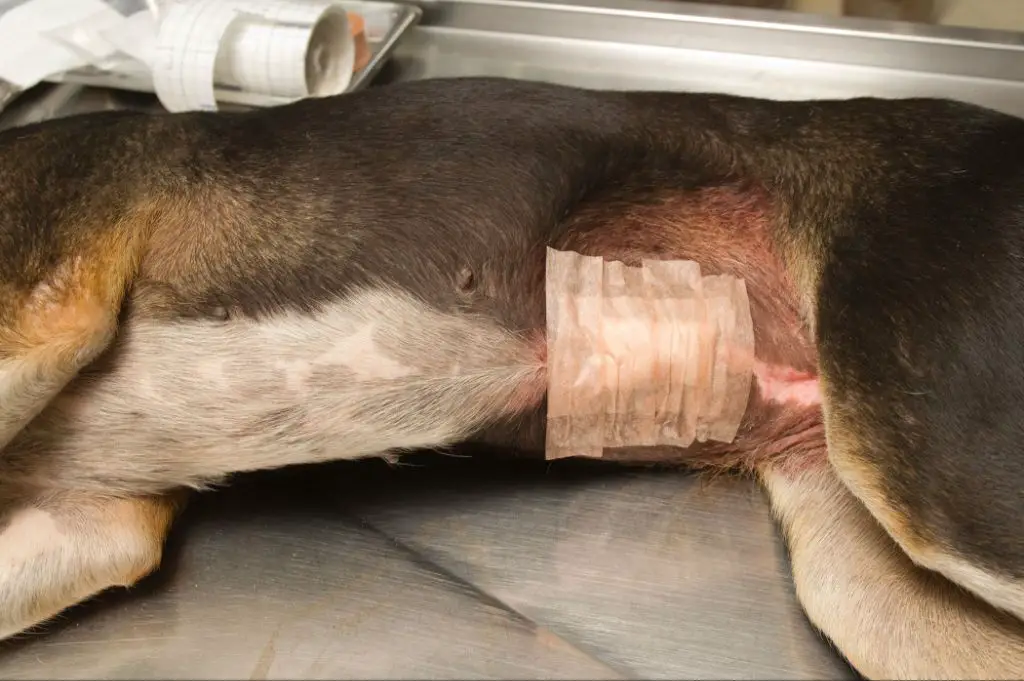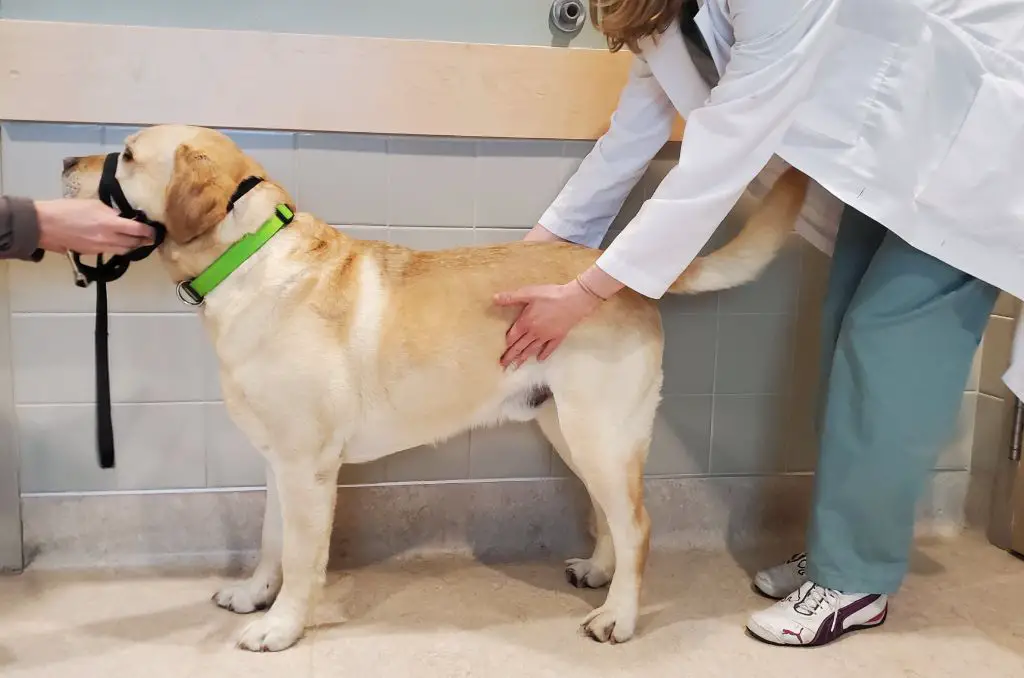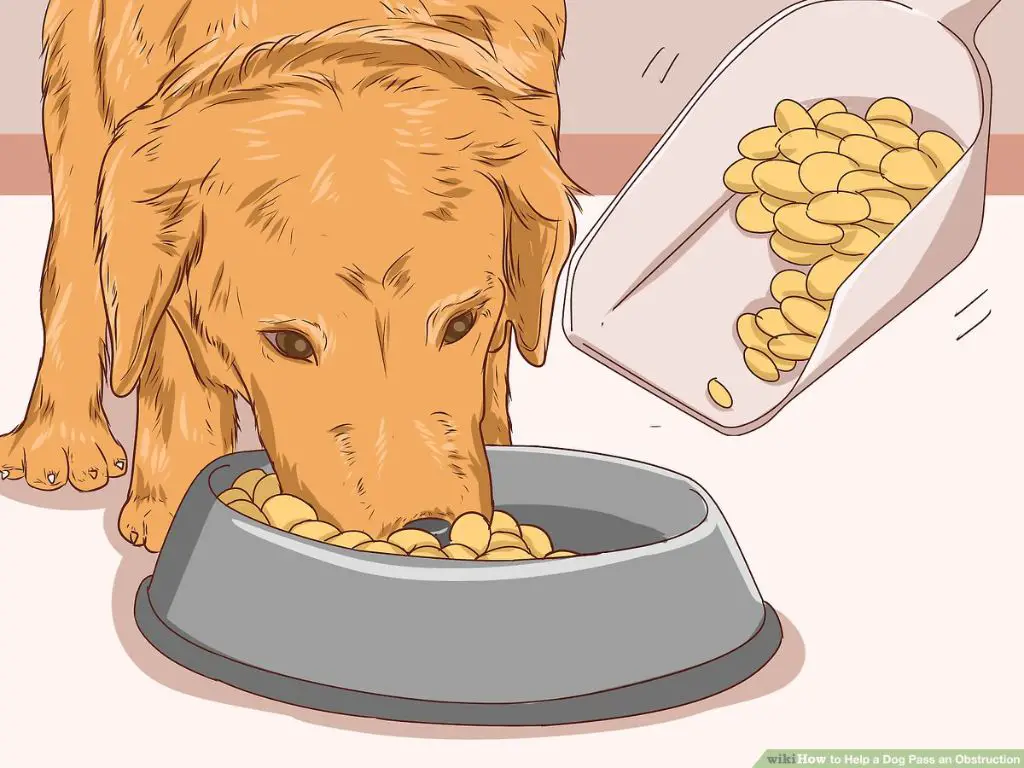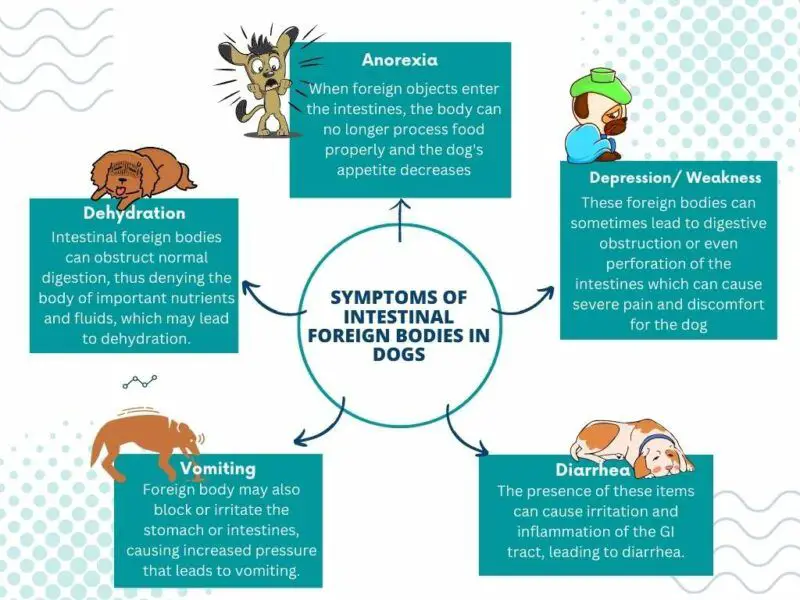Introduction
Intestinal blockages are a dangerous condition that can occur in dogs when a foreign object lodges in the gastrointestinal tract. Blockages prevent food and waste from properly passing through the intestines, leading to a buildup that can cause severe pain, vomiting, and even death if left untreated.
It’s critical for dog owners to recognize the early signs of a possible blockage. Quick action is essential, as blockages can rapidly progress from mild to a life-threatening emergency in just hours or days. Knowing when to seek veterinary care can truly mean the difference between life and death for a dog with an intestinal obstruction.
What Causes Blockages
There are a few common causes of blockages in dogs:
-
Swallowing foreign objects – Dogs are prone to eating things they shouldn’t, which can cause obstructions in their digestive tract. Items like bones, toys, sticks, rocks, and other objects may get lodged.
-
Eating too fast without properly chewing – When dogs eat too quickly and don’t chew their food properly, large chunks of food can get stuck in the esophagus or intestines.
-
Impacted food or hair – Sometimes undigested food, rawhide or hair can accumulate in the stomach and intestines, forming an impaction or wad that blocks the intestines.
Any object, food chunk or mass that is too large to pass through the intestines can potentially cause a blockage.
Early Signs
Some of the earliest signs that a dog may have a blockage include:

-
Decreased appetite – One of the first signs of a blockage is a lack of appetite or refusal to eat. A dog that suddenly loses interest in food may have an obstruction in their digestive tract.
-
Vomiting – Dogs will often vomit if they have a blockage. The vomiting may be food, foam, or yellow bile. Repeated vomiting is a clear sign something is obstructing the stomach or intestines.
-
Diarrhea – Some dogs with a blockage will pass runny or watery stool as the body tries to move contents past the obstruction. Diarrhea may contain blood or mucus.
-
Straining to defecate with little production – Dogs may frequently squat to poop but only pass small amounts of liquid stool or nothing at all. They may whine or lick their hind end due to discomfort.
-
Whining – Obstructed dogs may whine, whimper, or cry due to abdominal pain and discomfort. This whining tends to increase over time as the blockage worsens.
If a dog shows any of these signs, it warrants an immediate trip to the vet to check for potential blockage.
Advanced Signs
If a dog’s blockage is allowed to progress untreated, several dangerous symptoms can develop. These advanced signs indicate an emergency situation requiring immediate veterinary care.
Severe vomiting is a major red flag. A dog with a total blockage will be unable to hold down any food or liquid. Frequent projectile vomiting of large amounts is a sign of a complete obstruction.
Extreme lethargy and weakness often accompany a blockage. The dog will appear very ill and have little interest in activity due to dehydration and electrolyte imbalances.
As the blockage enlarges, it can cause abdominal distension. The dog’s belly may appear swollen or bloated. This swelling puts pressure on other organs.
Fever is another serious advanced sign. The dog’s temperature will often spike as high as 104 to 106°F. This indicates infection or inflammation related to the blockage.
If you observe any of these advanced symptoms in your dog, seek emergency veterinary care right away. Prompt treatment is vital to relieve the blockage and prevent lasting harm or even death.
Diagnosis
If a blockage is suspected, the vet will perform a thorough physical exam of the dog. They will palpate the abdomen to feel for any obstructions or an enlarged stomach. The vet will also listen for altered bowel sounds which can indicate a blockage.

Diagnostic imaging such as x-rays or ultrasound are commonly used to identify blockages. X-rays can reveal obstructions in the intestinal tract. Contrast studies may also be used, where the dog swallows a special dye that shows up on x-rays. This gives the vet a better view of the intestinal tract.
Bloodwork may also be recommended to check for signs of infection, electrolyte imbalances, and organ issues that could complicate treatment. Bloodwork provides additional information about the dog’s overall health to help guide treatment.
Treatment
Treatment for an intestinal blockage in dogs depends on the severity of the blockage and the dog’s symptoms. Here are the main treatments vets may use:
Withholding Food and Water
If the blockage is mild and the dog is still able to pass some food, the vet may recommend withholding all food and water for 12-24 hours. This rest for the digestive system allows any swelling around the blockage to go down so food can pass through more easily. Vets typically recommend introducing water first followed by small amounts of a bland diet after this fast.
Administering IV Fluids
Dogs with more severe blockages may need to be hospitalized and put on IV fluids. IV fluid therapy helps prevent dehydration and provides nutritional support while the blockage clears.
Surgery to Remove Blockage
If the blockage does not resolve on its own or with fasting and IV fluids, surgery is often necessary. There are a few different surgical procedures vets may use depending on the location and type of blockage. Most commonly, they will make an incision into the intestine to remove the obstruction.
Home Care
When a dog is suspected of having a blockage, home care is very important for their health and recovery. Here are some tips for caring for a dog with a potential blockage at home:

Close monitoring for signs – Keep a close eye on your dog for any worsening signs of a blockage. Look for increased vomiting, abdominal pain, weakness, loss of appetite, dehydration, pale gums, and lethargy. Track the time and severity of symptoms.
Withholding food – Do not feed your dog if a blockage is suspected. Food will likely make vomiting and GI upset worse. Withhold all food, treats, and chews until the blockage resolves or your vet advises you to reintroduce small amounts of bland food.
Encouraging hydration – Make sure your dog gets plenty of fresh water. You can also offer ice cubes or low-sodium chicken broth frozen into ice cubes. The fluid will help keep your dog hydrated without upsetting the stomach further.
Calling vet promptly – If your dog shows any concerning signs, does not improve, or worsens, call your vet promptly. They can advise you on next steps, such as bringing your dog in for an exam or emergency care.
Prevention
There are several steps dog owners can take to help prevent blockages from occurring:

Monitor your dog while they are eating. Supervise mealtimes and make sure they are chewing their food properly before swallowing. This can prevent them from gulping down large pieces that could get stuck.
Avoid exposing your dog to harmful objects. Keep things like rocks, toys, corn cobs, sticks, underwear, socks, string, etc. out of your dog’s reach. These kinds of items can easily cause an obstruction if swallowed.
Encourage proper chewing. Provide your dog with dental chews, rubber toys, or raw bones to chew on. Chewing helps break down food and objects into passable pieces before swallowing.
Brush your dog’s teeth regularly. Daily brushing reduces plaque and tartar buildup that can cause obstructions in some cases. It also lets you spot foreign objects caught in the teeth.
Prognosis
The prognosis for a dog with an intestinal obstruction is generally good if it’s treated promptly. With early veterinary intervention, many dogs make a full recovery. However, the prognosis becomes more guarded the longer the obstruction goes unaddressed. Prolonged blockages can lead to serious complications.
In mild cases of obstruction that are treated quickly, dogs usually respond very well to initial medical management. With fluids, anti-nausea medication, and gastrointestinal protectants, vets can often relieve the obstruction non-surgically over 24-48 hours. As long as the underlying cause is also addressed, these dogs go on to live normal lives.
However, if an intestinal blockage becomes severe due to a delay in treatment, dogs may develop significant dehydration, electrolyte imbalances, necrosis of the intestinal wall, septic peritonitis, or even septic shock. These complications can be life-threatening even with aggressive therapy. Dogs with extensive intestinal damage may require surgery to remove the affected portion of intestine.
Overall, timely veterinary care is key. While mild obstructions often resolve with medical management, severe or chronic cases may require surgery. Still, the vast majority of dogs have an excellent prognosis when treated appropriately.
When to Seek Help
Some signs of a potential blockage in dogs require urgent veterinary attention. If your dog exhibits any of the following symptoms, you should take them to the vet or emergency animal hospital right away:
Any vomiting or diarrhea lasting over 24 hours – Frequent vomiting and diarrhea can quickly lead to dehydration, electrolyte imbalances, and other problems. If the vomiting or diarrhea persists for more than 24 hours, get veterinary help.
Straining to defecate without production – If your dog is straining to poop but nothing is coming out, this indicates a potential obstruction in the colon or rectum. Prompt veterinary attention is needed.
Loss of appetite – An obstructed intestine will prevent food from properly passing through the digestive tract, causing a loss of appetite. Take your dog to the vet if they go more than 24 hours without eating.
Lethargy – Blockages can cause blood toxins to build up, leading to lethargy and weakness. Lethargy lasting more than 24 hours requires medical evaluation.
Don’t delay if your dog shows any of these symptoms – get them checked out right away. The sooner a blockage is addressed, the better the outcome will be.